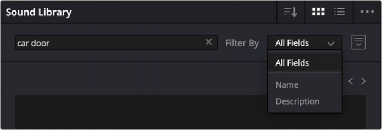< Previous | Contents | Next >
Display Controls and the Search Field
The Sound Library title bar has controls for sorting the sound effects list, showing it in List or Icon view, and an Option menu with various other settings and commands.
![]()
Display controls let you choose how the contents of the Sound Effects list are viewed
Underneath, a text field lets you enter search terms, while a drop-down menu to the right lets you choose whether to search the current project library for sound effects by name, description metadata, or all.

The Search field and Filter By menu
— Type a search term into the Search field. The case of search terms is ignored, except for boolean operators.

NOTE: If you want to perform Boolean searches, the Boolean operators must be typed in all upper caps, such as “AND,” “OR” and “NOT.” If lower case is used, “and,” “or” and “not” will be treated as search terms but as regular words.
NOTE: If you want to perform Boolean searches, the Boolean operators must be typed in all upper caps, such as “AND,” “OR” and “NOT.” If lower case is used, “and,” “or” and “not” will be treated as search terms but as regular words.
NOTE: If you want to perform Boolean searches, the Boolean operators must be typed in all upper caps, such as “AND,” “OR” and “NOT.” If lower case is used, “and,” “or” and “not” will be treated as search terms but as regular words.
To help you to eliminate false positives, the search field supports different kinds of searches, such as literal searches, and/or/not boolean searches, wildcard searches, and ranges of characters.
Or/And/Not Searches
Simply typing words separated by a space is treated as a series of OR searches for each word independently of one another, either literally or as part of another word. For example, if you type either of the following:
car door car OR door
both yield the same results. Every sound effect in your library containing either the letters “car” or “door” (or both) will appear, whether these letters appear independently, or within other words.
Results will include files such as “CarExDoorClose,” “Doormouse_Squeak,” “Carburetor dropped on cement,” and “Carpet Shake.”
Using AND (it must be upper caps) lets you specify multiple criteria for a search, when each file that’s returned should contain every word you type somewhere within, in any order. For example, if you type:
car AND door
every sound effect in your library containing both the strings “car” and “door” will appear, even if these words appear either singly, in combination, or within other words, such as “NewCarDoorSlam” and “Carpet_Footsteps_Indoors,” and “GarageDoorHitsCar.”
Using NOT lets you omit sound effects that have a particular word. For example, if you type:
car NOT door
only sound effects with “car” will appear, and all sound effects with “door” will be omitted.
Literal Searches
Using quotations specifies a literal search for only the specified term, separated from other text by a space. For example, if you type:
“cat”
every sound effect in your library with the standalone word “cat” appears. Sound effects with “cats” and “caterpillar” will be omitted. Results will include “Space cat drone” or “Cat meowing.”
Wildcard and Range Searches
The * (asterisk) specifies a wildcard search of any number of characters. Adding an * between two search terms identifies any sound effect with the two search terms connected by any number or combination of characters with no spaces (even no characters). For example, if you type:
close*door
results include “Door-Wood Cheap-Wooden-Closet-Door-Kick-In-Flimsy-Rattle,” “ElevatorCabinCloseDoor,” and “LatchSwingCloseSqueakDoorSecur.” If you instead type:
door*close
results include “DoorHvyMetalCloseSlam,” “DoorLidWoodenChestCloseAntique,” and “ElevatorDoorCloseSlam.” If instead you type:
c*r
results include “lectrohummin,” “KiaShumaEXTBootCloseTrunkaka,” and “Ambience with Piana, Louder.”
The ? (question mark) specifies wildcard search specifying only a single character. The number of question marks you type specifies how many characters of wildcard searching you want to perform. For example, if you type:
![]()
door?close
you may get no results at all, unless you have a sound effect named “door-close.” However, if you type:
door????close
results include “DoorWoodClose” since the word wood is four letters, matching the number of wildcard letters you’ve specified.

TIP: typing “***” will show all of the files in your Sound Library
TIP: typing “***” will show all of the files in your Sound Library
TIP: typing “***” will show all of the files in your Sound Library